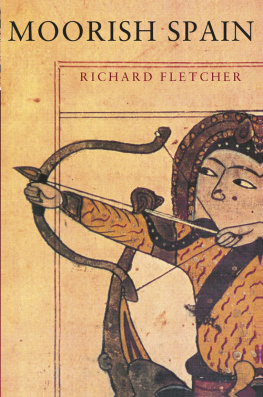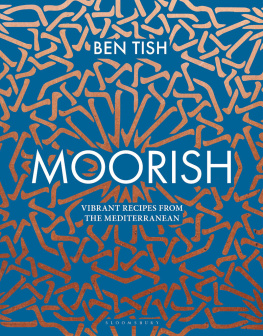To
Houston and Lucinda Shaw Stewart
incomparable travelling companions
in
Al-Andalus and the Maghrib
Moorish Spain
Richard Fletcher

CONTENTS
| The interior of the great mosque at Crdoba (Roland Michaud, John Hillelson Agency) |
| Ivory casket made in Crdoba in AH 359/AD 969-70 (Victoria and Albert Museum) |
| Fresco of figure praying, from the Pyrenean church of Sant Quirze de Pedret, c. 1000 (MAS, Barcelona) |
| Mozarabic architecture: the church of San Miguel de Escalada near Len (Spanish National Tourist Office) |
| Illustration of St John from a tenth-century manuscript (Pierpont Morgan Library, New York: M. 644, f.3v) |
| Santiago Matamoros (St James the Moorslayer), from an engraving of c. 1475 attributed to the School of Schongauer (Trustees of the British Museum) |
| One of the votive crowns of Guarrazar, now in the Museo Arqueolgico Nacional, Madrid (MAS, Barcelona) |
| The aqueduct of Segovia (Spanish National Tourist Office) |
| Partial reconstruction of the caliphal palace of Madinat az-Zahra near Crdoba (Roland Michaud, John Hillelson Agency) |
| A marble trough made for Almanzor in 987 now in the Museo Arqueolgico Nacional, Madrid (MAS, Barcelona) |
| A noria or waterwheel near Murcia (Rapho, Paris) |
| Astrolabe made at Toledo in 1068 (Museum of the History of Science, Oxford University) |
| A casket of wood and ivory carved at Cuenca for a member of the princely dynasty at Toledo in 104950 now in the Museo Arqueolgico Nacional, Madrid (MAS, Barcelona) |
| A silk textile of the eleventh century (Muse de Cluny, Paris) |
| The Almohad banner captured by Alfonso VIII of Castile at the battle of Las Navas in 1212 (Editions dArt Albert Skira) |
| The Torre del Oro at Seville (Spanish National Tourist Office) |
| James I of Aragon conquers Valencia: fresco of c. 1300 (MAS, Barcelona) |
| , | Mudejar church architecture, in the Aragonese town of Teruel (Spanish National Tourist Office) |
| Mudejar military architecture at Coca (Spanish National Tourist Office) |
| An example of Mudejar ceramics (Museo Arqueolgico Nacional, Madrid) |
| Averroes as represented in a western manuscript of the thirteenth century (Bibliothque National, Paris) |
| Christian and Muslim playing chess together, from an illustrated manuscript of Alfonso Xs treatise on the game (Escorial, Madrid) |
| , | The Synagoga del Trnsito in Toledo (Spanish National Tourist Office) |
| Granada, the Alhambra: the Court of the Lions (Colin Grant) |
| Granada, the Alhambra: the Court of the Myrtles (Colin Grant) |
| The enforced baptism of the Moors of Granada in 1499: detail from the Capilla Real, Granada, High Altar by Philippe Biguerny (MAS, Barcelona) |
Maps
The Iberian Peninsula c. 800
The Iberian Peninsula c. 900
The Campaigns of Almanzor
The Taifa States
The Shrinking of Moorish Spain
This book is intended as an introduction to the history and culture of Islamic Spain between the Berber invasion of the early eighth century and the expulsion of the Moriscos by Philip III in the early seventeenth. It lays no claim to deep or original scholarship. The reader I have had in mind while writing it is the inquisitive traveller in Spain who might want to know something more than a guidebook can tell him about the people who built the mosque of Crdoba or the Alhambra at Granada. If it serves this purpose I shall be well satisfied.
I acknowledge with gratitude the advice and encouragement of Andrew Best, and the constructive editorial vigilance of Allegra Huston. To them I offer my thanks.
Richard Fletcher
Nunnington, York
1992

In the year 711 a Berber army under Arab leadership crossed the Straits of Gibraltar from Morocco in continuation of a series of raids which had been going on for some time. The army was commanded by a general named Tariq who is said to have given his name to his landfall on the northern side of the Straits: Jebel Tariq, the Rock of Tariq, Gibraltar. In the following year a battle was fought between the invaders and the army of Spain under its king Roderic or Rodrigo and astonishingly Tariqs troops were victorious. King Roderic was slain and the invaders went on to take the capital city, Toledo. Within a very few years the entire peninsula lay at their feet. As in England in 1066, the fortune of a battle had decided the fate of a kingdom.
In Spain it had decided very much more than this. The early eighth-century conquest signalled the beginnings of an Islamic presence in the Iberian peninsula that would endure for the better part of a thousand years and whose impress upon peninsular culture is still discernible. What is more, Islamic Spain would come in time to offer the fruits of a higher civilisation to barbarian Europe beyond the Pyrenees. European acceptance of this legacy, hesitant at first and then full-hearted, decisively affected western culture, not just in Europe but also in those New Worlds discovered and settled by Europeans in the early modern period. So much may be said to have stemmed from Tariqs raid. That is why, in the last resort, Moorish Spain is worth trying to understand.
We are ourselves responsible for some of the obstacles that prevent understanding. Consider this passage, for example:
Beautiful and fierce, seductive and pagan, Andalusia is a world unto itself. Probably no other region in Europe is so romantic, mysterious and atmospheric with its incredible Moorish legacy, its vast mountains, parched plains, superb cities and magical villages.
The words are those of a British travel brochure designed to appeal to the discerning holidaymaker who sets his sights higher than the bars and fish and chip shops of, say, Torremolinos. Banal they may be, but they hold out a promise which echoes existing expectations of romance, mystery and atmosphere. Such expectations are fairly recent. They gained currency during the Romantic movement of the nineteenth century. For the English-speaking world two authors in particular seem to have been largely responsible for this image of southern Spain: Washington Irving (17831859) and Richard Ford (17961858). Irving, a member of the United States legation in Madrid from 1826, travelled widely in the south and published his very popular Tales of the Alhambra in 1832. Ford, who lived for three years in Seville in the 1830s and also travelled indefatigably, published his Handbook for Travellers in Spain in 1845, a work which was long to remain the indispensable companion for English visitors. These two works, and others which bobbed along in their wake, did much to shape Anglo-American assumptions about the character of Spain, especially southern Spain, her people and their customs. These assumptions have left their mark in surprising places; for instance in the deservedly celebrated childrens tale of Ferdinand the Bull. The brochure quoted above shows that they are still very much alive.
Any attempt to understand the history and culture of the Iberian peninsula must take account of that incredible Moorish legacy: but the enquirer should be prepared to find the reality less exotic than the stereotype. Less exotic, yes, but certainly unfamiliar to those habituated like Irving and Ford to the cultural traditions of the English-speaking peoples. Consider the most famous architectural monument of southern Spain, the great mosque of Crdoba, built in stages between the late eighth century and the late tenth. Here is a building which is constructed in accordance with an architectural aesthetic which is utterly different from that governing the design of the places of worship of the Christian west. In a church there is a line of tension which runs from west to east; the eye is led unerringly to the altar. There is no comparable focus in the great mosque. True, it has (like other mosques) a
Next page










